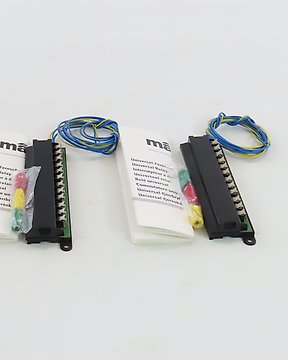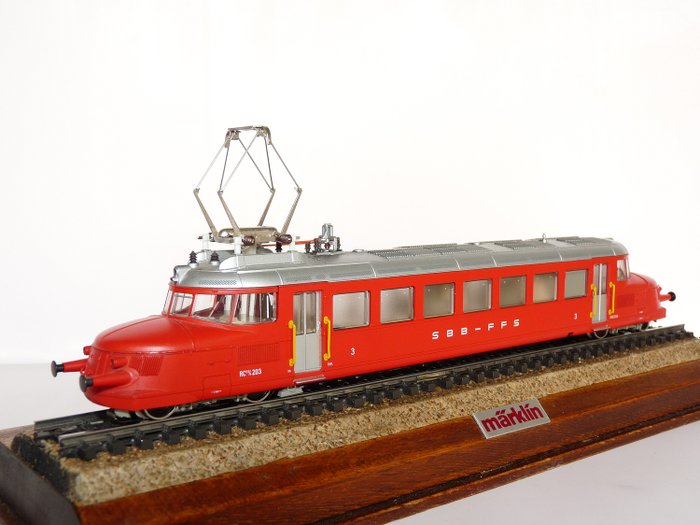
Märklin H0 - 7244 - Elektroniikka (3) - 3x yleinen kytkentärele
Nro. 30214617

Nro. 30214617

Märklin H0 - 3605 - Electric train unit RBe 2/4 'Red arrow' of the SBB CFF
With original packaging, without booklet
Running number: RBe 2/4 203
Red colour scheme.
Full metal locomotive.
All functions have been tested.
No breakages
Some paint damage on the roof
Bottom cover missing
With a new pantograph
Please see the photos of this very beautiful locomotive.
The presentation rail is not a part of this offer.
The train sets of the Series CLe 2/4, better known as "Roter Pfeil - Red Arrow", were electric motorised carriages of the Schweizerische Bundes Bahnen (SBB) which were deployed with the SBB from 1935 onwards. A total of 7 units were built. From 1944 onwards these train sets were often converted and re-classified as the Series Rbe 2/4, RCe 2/4 and RAe 2/4. One of the train-sets was sold in 1974 to the Swiss Oensingen-Balsthal-Bahn AG (OeBB). This was the CLe 2/4 207 which was re-classified as the Rbe 2/4 with the OeBB, with Company Number 202. This set was repainted in blue, earning it the nickname "Blue Arrow".
Development and operation:
In 1933, the SBB ordered 4 railcars of which 2 electric and 2 diesel-electric railcars. The electric motorcars were delivered in 1935 and were intended to improve the timetable on the sidelines. The electric motor cars were classified as CLe 2/4 and could reach a maximum speed of 125 km/h. It soon turned out that the electric railcars were a success and as a result this was immediately followed by reordering 4 additional railcars of this series. These were delivered in 1936. In 1937, another seventh railcar of this series followed. In the same year the railcars were reclassified as Re 2/4. The railcars offered 70 seats and standing room for 30 passengers and were equipped with a compressed air mechanism to open and close the sliding doors. The CLe 2/4 was also deployed for tour groups and was very popular with the traveller because of its comfort and appearance. The storage of luggage proved to be a problem in practice as this often was at the expense of available seats. In addition, many travellers adjusted their travel plans in such a way that they could join the ‘Red Arrow’ service. As a result, at times some 200 people would be jostling to join the ‘Red Arrow’, while there was only space for a maximum of 100 persons. Because of this and partly because the railcars were not suitable for connecting a luggage wagon, the SBB decided take the rail cars out of the general service and to use them primarily for tour groups and transport of winter sports passengers. In order to minimise the baggage problem for winter sports travellers, a small ski trailer was purchased in 1937 which was coupled behind the CLe 2/4 and contained the ski luggage. Railcars 204 to 207 came with these ski trailers. The railcar 205 was deployed together with a ski trailer by the Oensingen-Balsthal-Bahn AG (OeBB)
In 1944, these trains were fitted with buffers and screw couplings, so that they could pull an extra passenger carriage or baggage carriage. After this adaptation, the trains were classified as RCe 2/4 in 1947-1948 and were assigned the numbers 601 and 602. In 1952, one railcar (the 606) was lengthened by 2.6 m and the interior was also renewed, with comfortable upholstered seats with more seating space. This was classified as RAe 2/4 and was given the company number 1001. The 601, which crashed in 1953, was also extended and, like the 606, provided with upholstered seats. From 1956 onwards, all other railcars were fitted with buffers with screw couplers and were all classified as RBe 2/4 and the operating numbers 601 to 607 were adjusted to 1001 to 1007. The 2 extended railcars were classified as a series RAe 2/4 and the company numbers 1001 and 1002 were assigned to them.
In 1966, the first train set of the CLe 2/4 was taken out of service and scrapped. Until 1974, 2 vehicles remained in the SBB stock, one of which was sold to the OeBB and -in unusual blue livery- was still deployed for several years.
Näin ostat Catawikistä
1. Löydä jotain erityistä
2. Tee korkein tarjous
3. Maksa turvallisesti